Browse Primary Sources
Locate primary sources, including images, objects, media, and texts. Annotations by scholars contextualize sources.
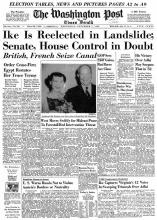
The Washington Post Announces Eisenhower's Reelection
A newspaper is a publication intended for a broad audience that appears regularly, often daily, and claims to contain factual accounts of recent events. The Washington Post, for instance, has reported on the presidential elections in the United States since 1880, and is proud to count itself a historic member of the "campaign reporting business."
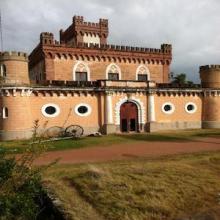
Castillo de Piria
This castle-like home once belonged to Francisco Piria, a Uruguayan entrepreneur and the founder of the town of Piriápolis. He lived from 1847 to 1933. Piria was the child of Italian immigrants, who comprised a major portion of the population in the Rio de la Plata region during this period. He grew up in the capital city of Montevideo and attended school in Italy.
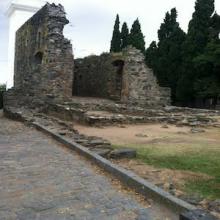
Ruins of the Convento de San Francisco
These structures are all that remain from a convent built near the coast of modern-day Uruguay in the 1690s. It is located in Colonia del Sacramento, a city that switched back and forth from Spanish rule to Portuguese rule several times during the seventeenth through the nineteenth centuries. Its unstable political identity resulted from its positioning in a highly contested region.
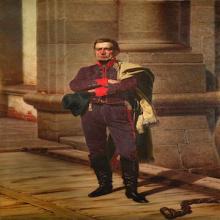
Portrait of General Artigas
José Gervasio Artigas Arnal (1764-1850) was a Uruguayan soldier who became a national hero for his contributions to the wars of independence from Spain. He is a celebrated figure in Uruguayan culture, and his name has become ubiquitous throughout the country. For example, one of the main roads in its capital city of Montevideo is Artigas Bulevard.
New York Times editorial on Mexico, November 21, 1855
The New York Times was founded in 1851. It was an antislavery newspaper before the Civil War, helping to establish the Republican Party in 1854. It covered international as well as national and local affairs. Historians regard the Times as a gauge of American opinion at the time.
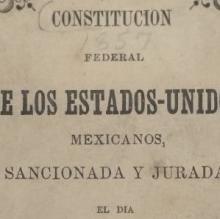
Federal Constitution of the United Mexican States of 1857
The Federal Constitution of the United Mexican States of 1857 was a liberal constitution. It replaced an organic law of 1836 that had given dictatorial authority to President Antonio López de Santa Anna, who was overthrown after selling parts of Sonora and Chihuahua to the United States in the Gadsden Purchase.
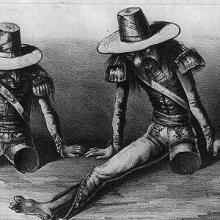
Mexico Cartoon, 1846
This cartoon was published in New York in June 1846 as a lithograph, a month after the United States declared war on Mexico on May 13, 1846 to begin the Mexican-American War, which resulted in U.S. annexation of Mexico’s northern territory. Lithographs were printed cheaply from original drawings using crayon, limestone, and rolled-on ink.
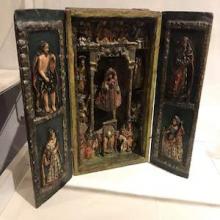
Wooden Triptych
This small wooden piece was constructed as a triptych, with two side panels that can fold over the main panel. It displays religious imagery, with the Virgin Mary at the center. The time period is unclear. The other figures remain unidentified, but are likely religious figures or images of the individuals who commissioned the piece. This item was intended for personal devotion in the home.
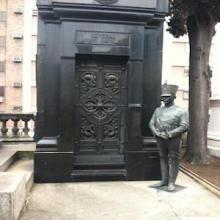
Tomb of General Juan Lavalle
Argentina declared independence from Spain in 1816 and eventually achieved it after several years of fighting royalist forces. Juan Lavalle was born in Buenos Aires in 1797, and remained in Argentina for most of his life. He joined General San Martin to fight for independence across South America.

The Obelisk of Buenos Aires
Built 1936 to commemorate the anniversary of the founding of the city, the Obelisk stands in downtown Buenos Aires, Argentina. It stands 67.5 meters tall, made of concrete and stone. The nation of Argentina celebrates its independence day on July 9th. This monument is located in the historic heart of town, at the intersection of July 9th Avenue and Corrientes Avenue.

Remains of the Puerta de la Ciudadela
The city of Montevideo, Uruguay, once belonged to the Viceroyalty of the Rio de la Plata, under the control of the Spanish Crown. It was officially founded in 1724. Around this time, the government constructed a wall around the city. Such walls served important defensive purposes, especially for places like Montevideo, which directly bordered the sprawling Portuguese territory of Brazil.
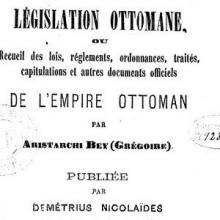
Ottoman Reform Decree, 1856
The Imperial Reform Edict of Ottoman Sultan Abdulmejid I, appearing originally in 1856 and subsequently in this 1874 publication, promised equality of access to education, government appointments, military service, and administration of justice to all, regardless of religion, language, or race.
Poem by Qiu Jin, Chinese feminist
While the discussion surrounding the Chinese practice of footbinding often focuses on the writings of western missionaries, the example of Qiu Jin, a Chinese feminist and poet, demonstrates that the practice was criticized by Chinese individuals as well. Qui Jin had her feet bound as a child and as an adult spoke out against the practice.
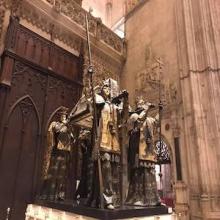
Remains of Christopher Colombus
In October of 1492, the Spanish monarchs sponsored a voyage led by Columbus and his crew, who intended to sail towards India. Instead, they set foot in the Americas for the first time. Over the next several years, Columbus made many trips back and forth between Spain and the Caribbean Islands.
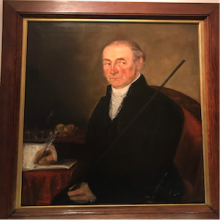
Portrait of Manuel Mansilla
This painting depicts Manuel Mansilla, the Alguacil Mayor (sheriff) of the city of Buenos Aires. He held this position from 1795-1821, during a key transitional moment. When he began his tenure, the city belonged to the Viceroyalty of the Rio de la Plata, under Spanish rule. However, by 1821, the region was establishing its independence as the nation of Argentina.
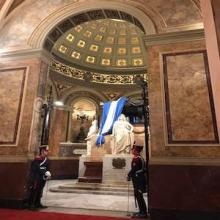
Mausoleum of José de San Martín
In 1816, after more than two centuries of Spanish rule, the nation of Argentina declared its independence. One of the leaders of the independence movement was José Francisco de San Martín y Matorras, more commonly known as General San Martín. He fought in battles in Argentina, Peru, and Chile. The Argentine public has historically regarded him as a father of the independence movement.
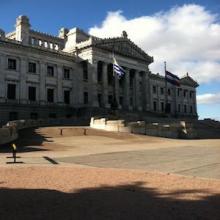
Legislative Palace of Uruguay
The Legislative Palace of Montevideo, Uruguay, was built in the early twentieth century. Construction lasted from 1904 to 1925 under the supervision of Vittorio Meano and Gaetano Moretti. It is located in the Aguada barrio, or neighborhood, of the city. Since Montevideo is the capital of the nation of Uruguay, the Palace houses the major legislative bodies of the nation.

Indian textile fragment, 14th-15th century
This block-printed, cotton textile fragment, found in Old Cairo, Egypt, was made in Gujarat, India. It features a repeated stylized tendril pattern made by stamping red-brown dye on the cloth in vertical sections.
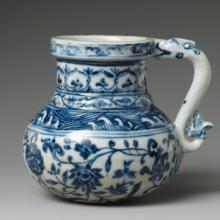
Porcelain tankard, fifteenth century China
This Ming dynasty porcelain tankard incorporates some Chinese elements, such as the peony flower design on the body and the dragon-shaped handle. Its shape was not Chinese, however, but based on Islamic metalwork, which indicates it was made for export.
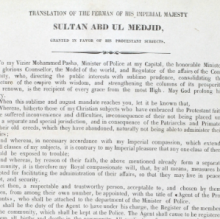
Ottoman Decree Regarding Protestants, 1850
This imperial decree, or firman, was translated from Ottoman Turkish to English by the American Board of Commissioners for Foreign Missions.